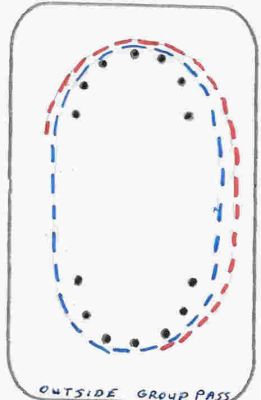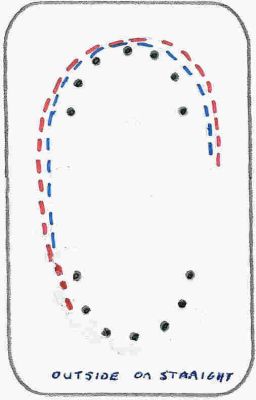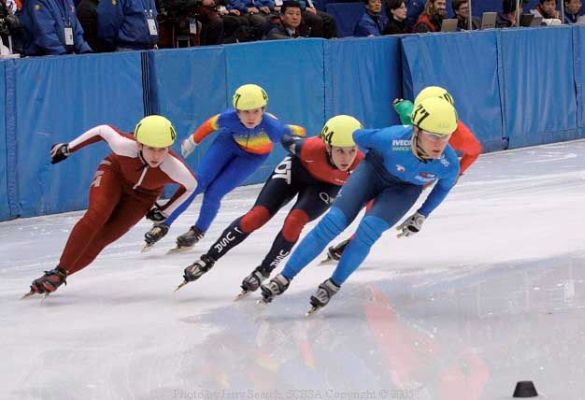The Outside Pass
By Susan Ellis, February 2006
Short track skating is a game of strategy and tactics. Skaters need to be skilled at passing both on the inside as well as the outside, and need to recognize the situations when to use each type of pass.
Too often skaters get fixated on passing inside when there is simply no room, so they get jammed up or disqualified. An outside pass is often safer, and when well timed, harder to defend against.
Outside passing, while easy to perform just about anywhere on the track at lower speeds, requires ultimate track placement, timing, and proper speed of execution at higher speeds.
There are three types of outside passes:
The placement and execution of each type of pass is very different.
Outside large group pass
An outside large group pass (4–5 people), while not impossible at super high speeds is very difficult, therefore the set up, timing, and execution are critical. The pass is executed mostly on the corner but depending on the speed, and number of people to pass, may need to be started on the straightaway before entering the corner.
The large group outside pass is a great one to use in a breakaway attempt, when the pack is going at a fairly relaxed pace. Your wider track, and aggressive entry gives you the speed to open up a gap.
If your intention is not to break away, but simply to get to the front of the pack and just maintain the same pace the pack was going, you will need to gauge your pass speed to be able to simply slip in front of the first skater without creating a huge gap. Once you open a gap, the pack may start scrambling as they think a breakaway is on. It is also important to pass QUIETLY. If you make too much noise passing the first few skaters, the front skaters know a pass is coming and they can then simply speed up to keep you behind.
Common errors in the outside large group pass:
Too often skaters get fixated on passing inside when there is simply no room, so they get jammed up or disqualified. An outside pass is often safer, and when well timed, harder to defend against.
Outside passing, while easy to perform just about anywhere on the track at lower speeds, requires ultimate track placement, timing, and proper speed of execution at higher speeds.
There are three types of outside passes:
- An outside pass on a large group (4 or more)
- A small group (2-3 person) outside pass on the straight
- A one person pass outside on the entry
The placement and execution of each type of pass is very different.
Outside large group pass
An outside large group pass (4–5 people), while not impossible at super high speeds is very difficult, therefore the set up, timing, and execution are critical. The pass is executed mostly on the corner but depending on the speed, and number of people to pass, may need to be started on the straightaway before entering the corner.
- You will need to take your acceleration for the pass starting on the previous corner, as you exit the turn (#1). If the speed is high you may need to start your acceleration on the entry rather than the exit.
- By the last block on the previous corner you should have moved to a position just to the outside of the last skater (#2).
- You continue your acceleration down the straightaway, and catch the third skater in the group by the 1st block (#3). At the highest speeds, you may need to have already caught the third skater by the center red line.
- You must accelerate hard in to the apex block with good two crossovers, staying very close to the outside shoulder of each skater you are passing. By the apex block you should be drawing up on the outside of the second skater (#4).
- You should be going by the first skater by the last block (#5). It is critical not to catch the first skater too early in the turn. The problem with this is they can see and feel you coming up on them. If you do, a strategically adept skater will simply accelerate hard out of the corner and keep you on the outside. And believe me, it sucks to be stuck on the outside for several laps at a time! Waiting until their focus has shifted up the straightaway (i.e.: at the 5th or 6th block) will help you to complete your pass in a sneak attack.
The large group outside pass is a great one to use in a breakaway attempt, when the pack is going at a fairly relaxed pace. Your wider track, and aggressive entry gives you the speed to open up a gap.
If your intention is not to break away, but simply to get to the front of the pack and just maintain the same pace the pack was going, you will need to gauge your pass speed to be able to simply slip in front of the first skater without creating a huge gap. Once you open a gap, the pack may start scrambling as they think a breakaway is on. It is also important to pass QUIETLY. If you make too much noise passing the first few skaters, the front skaters know a pass is coming and they can then simply speed up to keep you behind.
Common errors in the outside large group pass:
- Starting the acceleration too late. Many skaters think they can get by just by starting the acceleration on the same entry as the corner they are passing on. Then they don’t have enough speed to pass before the 5th or 6th block on the exit, and are left out to dry on the outside. On a narrow rink this has even great consequences as you will run out of room to pass as the group drifts towards the boards on the exit.
- Starting the acceleration too early. If you start your acceleration too early and catch the first skater as they are starting their entry, again they will just accelerate hard in to the corner and leave you hanging on the outside.
- Not accelerating hard enough in to the entry. To have the speed to pass on the exit, you must accelerate hard in to the entry, taking two, or even three crossovers in to the apex block.
Outside small group pass
To pass a small group of 2 to 3 people you can use the corner outside pass, or use the outside on the straight as it has a bit more of an element of surprise when properly timed. Don’t try this one on a large group as you will run out of room and time to pass before you hit the entry.
- The pass is set up on the entry in to the turn (#1). You move towards the outside shoulder of the last skater ahead of you. If the speed is super high you will need to start your acceleration on the previous turn and continue to accelerate hard down the straightaway.
- You go slightly wider and deeper in to the turn (#2). This creates a slight gap to give you room to accelerate. Take two crossovers in to get your acceleration up.
- You should be accelerating up on the outside shoulder of the last skater just past the apex block (#3).
- You draw even with the first skater at, or just after, the last block (#4).
- Continue to accelerate hard down the straight so that you have almost completed your pass by the red line (#5).
- Come back towards the inside to be directly ahead of the first skater as you enter the turn to prevent a retake on the inside (#6).
Again timing, acceleration at the right time and the right place are crucial to ensuring a successful pass. If you start your acceleration too early and catch them too early they will know you are coming and accelerate to keep you behind. If you start it too late on the straight you will be hung out to dry on the entry and all through the next corner.
One person pass outside on the entry
The one person pass on the entry (also called an outside going in) has the biggest element of surprise and is the hardest to protect against.
- The pass is set up by starting your acceleration just past the apex block (#1). (Start on the entry at higher speeds.)
- By the last block you should have moved to the outside shoulder of the skater ahead. (#2) Continue your acceleration hard out of the corner. Here’s where you’ll need all your strength and power. Hopefully you’ve been working on your technique to have a strong exit.
- You should draw even with the skater just past the red line (this is when their focus is starting to shift to the entry and they are not expecting you to pass then (#3).
- You should be accelerating past the skater by the first block (#4).
- Come back in to the blocks as soon as there is an opening, ahead of the other skater (#5) and continue to accelerate hard through the entry so you can have good speed on the exit and prevent a retake.
Programs to practice outside passing
Every training session should have either a technical focus, or a tactical focus, or both. Good programs to practice outside large group passing are the longer endurance laps type of programs. E.g.: 6 x 20L @ 75% speed. Last person sets up a pass on the entire group every ½ lap. If you have a group of 5 skaters this would mean each skater is executing a pass every 2.5 laps. You really have to control the speed of the group on this program to make sure the group stays very close together.
A program for the outside small group pass might be 3 x 3 x 6L @ 80%. Only one pass per lap is executed. For a group of 3 skaters, this means 2 passes per interval, for a total of 18 passes during the program.
A program for the one person outside going in: 3 x 3 x 4L @ 90-95%, one pass per lap (each skater passes only every second lap).






